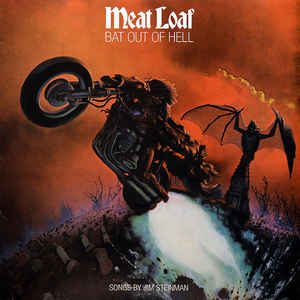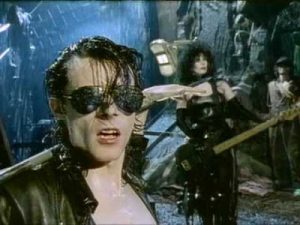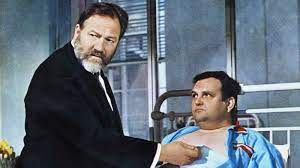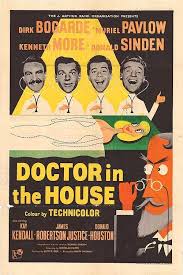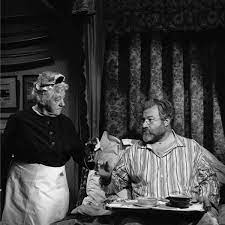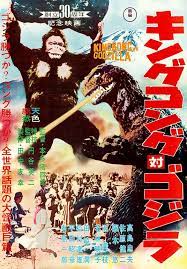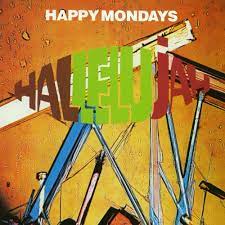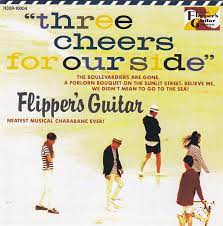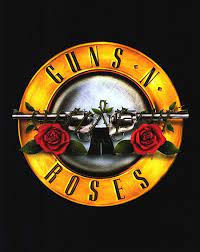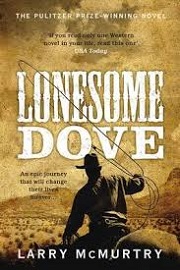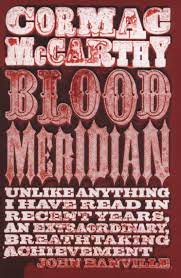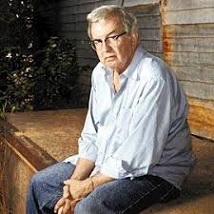
From amiddleagedwitch.wordpress.com
Today, March 13th, 2021, marks the 25th anniversary of the passing of Italian director Lucio Fulci. Here’s a reposting of a lengthy treatise I wrote about the mighty Fulci back in 2014.
Nowadays, satellite television can beam any subject matter, however adult, into our living rooms. Thanks to this, the whole family, from grandma and grandpa down to the pre-school infants, can now sit together in front of the TV and enjoy, communally, such splendid sights as the bit in season three of The Walking Dead (2012-13) where Danai Gurira grabs a big jaggy chunk of glass and rams it in extreme close-up into David Morrissey’s eyeball. Even better, a few minutes later, they can enjoy the sight of David Morrissey, again in extreme close-up, pulling the jaggy glass out of his eyeball.
This wasn’t always the case. Audiences didn’t always have easy access to images of extreme eyeball abuse. Indeed, three decades ago, a scene where a person got a humongous wooden splint stuck in her eye while being dragged through a hole in a door by a mouldering zombie was enough to cause outrage amongst the powers who decided what British film-fans could and couldn’t watch. The scene belonged to the 1979 Italian horror movie Zombie Flesh Eaters, directed by the inimitable Italian filmmaker Lucio Fulci. And it was the gory content of this and movies like it that led to Britain’s Video Nasties scare of the early 1980s.
By 1983, the Department of Public Prosecutions, cheered on by the likes of public-morality campaigner Mary Whitehouse and the right-wing British tabloid press, had drawn up a list of 72 films deemed liable to ‘deprave and corrupt’ and thus open to prosecution under the Obscene Publications Act. 39 of the 72 were successfully prosecuted. The remaining 33 weren’t prosecuted or were subject to unsuccessful prosecutions, but at the time you had little chance of seeing them through legitimate means.
Now that the hysteria has long passed, the majority of these films are available in uncut versions in Britain. A couple of them, like Don’t Go into the Woods (1981) and Contamination (1980), have even suffered the ultimate humiliation. They’ve been awarded wussy ‘15’ certificates.
Among the movies Lucio Fulci directed, two, Zombie Flesh Eaters and 1981’s The House by the Cemetery ended up on the list of 39 prosecuted titles; while a third, 1981’s The Beyond, was on the list of 33 that escaped successful prosecution. A fourth, 1980’s City of the Living Dead, didn’t make the Nasties list, but British police seized videos of it nonetheless. A fifth, 1982’s The New York Ripper, wasn’t classified as a Nasty either but still got banned from British cinemas. For this achievement alone, I think Lucio Fulci deserves respect.
I have a complicated relationship with Fulci. I doubt if I’ve ever seen more than one or two things he’s directed that I’d classify as good films, but I have to admit that when I encounter a new Fulci title in a DVD store or see one scheduled for broadcast on the Horror Channel, my pulse speeds up. I get a prickly, sweaty sense of excitement. I tell myself, I have to see this. Although the end result is usually the same. After the damned thing has finished, I sit back and feel a strange combination of bemusement, queasiness and disappointment, while a voice nags at me: “What the hell was that about?” Although to be fair to Fulci, there’s usually been at least one sequence in the film that’s made me think: “Wow!”
Lucio Fulci didn’t find fame, or infamy, in the English-speaking world until the late 1970s, but he’d been a staple of Italian cinema for a long time before. He started as a scriptwriter, first of all working on the 1954 comedy Un Giorna in Pretura. In 1959, a dozen film-scripts later, he began directing. One of his earliest directorial efforts was Ragazzi del Juke-Box, a musical starring the soon-to-be 1960s pin-up Elke Sommer. During the 1960s and 1970s, Lucio beavered away making comedies and spaghetti westerns. He also tried his hand at directing giallo movies, those twisted, kinky, violent and macabre Italian variations on the thriller genre: 1969’s Unna Sull’atra, 1971’s A Woman in a Lizard’s Skin and 1972’s Don’t Torture a Duckling.

© Medusa Distribuzione
Of Fulci’s giallo films, I’ve only seen Don’t Torture a Duckling and it’s surely one of the best things he did. It has none of the excess and goofiness of his later horror films and it benefits from its distinctly un-giallo-like setting. While most examples of this sub-genre take place in an affluent urban world inhabited by high-fliers in the creative industries (photographers and fashion models are common), Duckling is set in a rural and backward south Italian village, its separation from modernity symbolised by the nearby highway where traffic rumbles past oblivious to its existence. While the setting allows Fulci to take pot-shots at the institutions of conservative, traditional Italy, his cameras film the countryside there sumptuously.
That said, viewers today will be troubled by some early scenes, seemingly played for humour, which show heroine Barbara Bouchet teasing the village’s young boys by brazenly exposing herself to them. Imagine if the film had had hero Tomas Milian exposing himself to the village’s young girls. It’s a clumsy foreshadowing of the film’s themes, which are the threat posed to childhood innocence by an immoral world, and a serial killer’s determination to preserve that innocence by any means necessary.
Some commentators have noted that Fulci’s sudden interest in giallo movies, and hence in darker, bloodier material, coincided with the death of his wife Maria, who in 1969 committed suicide after discovering she had cancer. But the director himself never mentioned a connection between this personal tragedy and the darkening tone of his films.
The release of Zombie Flesh Eaters in 1979 saw Fulci plant his flag both in horror-movie territory and in the consciousness of impressionable, sensation-hungry teenagers, as I was then. The film was a success despite critics slamming it as an inferior cash-in on George A. Romeo’s seminal zombie movie from the previous year, Dawn of the Dead.
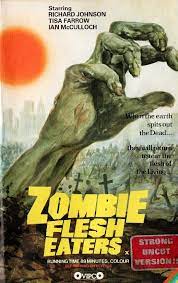
© Variety Film
Well, Zombie Flesh Eaters isn’t as good as Dawn of the Dead, but it has an undeniable something about it. The story kicks off with an un-crewed boat drifting towards New York Harbour while a ravenous zombie lurks in its hold. Then it shifts to the Caribbean island from which the boat originated, where a full-scale zombie epidemic, possibly scientifically induced, possibly supernatural, is underway. And at the very end it returns to New York, which has now succumbed to a zombie onslaught too. The stuff in New York is ropey but the scenes on the Caribbean island, depicted as a cursed, pestilent and windswept hellhole, are wonderfully atmospheric. A sequence where the protagonists stumble into a ‘conquistadors’ cemetery’ and the graves start disgorging some ancient cadavers is especially hard to forget.
But even that scene is surpassed by an earlier one where a female scuba diver flees from the predations of a large shark and hides behind a coral reef; only to discover that on the other side of the reef there lurks – eek! – a soggy underwater zombie. The shark and the zombie then proceed to fight, in a slow, balletic way. It’s typical of Fulci’s best sequences in that it manages to be simultaneously bizarre, haunting and totally bonkers.
The film is helped by the presence of two British performers, Ian McCulloch and Richard Johnson, who just ignore the absurdities of the situations and dialogue and get on with some proper acting. I read an interview with McCulloch a while back and he professed himself bemused by Fulci’s filming techniques in New York. These involved the cast and crew turning up at a spot, filming without any licence, and then clearing off as soon as the police appeared. This might explain the film’s curiously disjointed final image, which shows an army of zombies shuffling along an elevated bridge whilst below the New York rush-hour traffic trundles back and forth as if it’s just a normal evening.
The female lead, played by Tisa Farrow, is bloody awful, though. Tisa is the younger sister of Mia Farrow, and I’ve often wondered what the pair of them talked about when they met up during this period. “Oh hi, Tisa. I’m busy making A Wedding with Robert Altman and Death on the Nile with Peter Ustinov. What are you up to?” “Well, I’m fighting off a horde of flesh-eating zombies in a conquistadors’ cemetery with Lucio Fulci.” Mind you, considering what Mia had to endure with Frank Sinatra and Woody Allen, maybe she thought her kid sister had the better deal.
Zombie Flesh Eaters is one of my favourite Lucio Fulci movies because it has a story, one where things move from A to B and then to C. Unfortunately, for his next horror movies, Fulci decided that there’d be a common theme. Each would take place in a locality that, unknown to the inhabitants, rests on top of a portal to hell. And if you’re on top of a portal to hell, the laws of physics, of cause and effect, of A leading to B and to C, will be suspended. All sorts of crazy things will happen. The dead will rise, furniture will levitate, dogs will go mad, eyeballs will bleed, the sky will rain maggots, demonic winds will blow in your windows and satanic spiders will chew your face off. But there won’t be anything like a logically sequenced plot.
Many film fans have applauded Fulci for doing away with such outdated, bourgeoisie concepts as ‘plots’ in his films, but I have to say I find it a cop-out. This ‘portal to hell’ stuff was just an excuse for him to make things up as he went along.
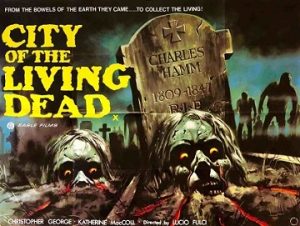
© Medusa Distribuzione
First in this series was 1980’s City of the Living Dead, which centres on strange goings-on in a remote American town that, by bad luck, is built on one of those afore-mentioned portals to hell. The townspeople are soon falling victim to various forms of supernatural mayhem, which are orchestrated by a ghostly priest and a clutch of zombies who apparently have the power to teleport from one place to another. City is a shambolic film. Well, what else can you expect when there’s teleporting zombies in it? But as usual with Fulci there are scenes that really stick in the memory. I particularly like one where the protagonists explore some catacombs under the local graveyard, unaware that the cobwebby old cadavers there are stirring into life the moment they pass by.
A sequence that all viewers of City remember is one where a girl sits paralysed in a car while the ghostly priest leers in at her and, under his malevolent influence, she starts to vomit up her own entrails. Lovingly captured on Fulci’s camera, those entrails ooze from her mouth in a slow, slimy mass. The actress who had the honour of playing this scene was starlet Daniella Doria. She had to sit before the camera with her mouth crammed full of sheep’s offal, which she then slobbered down her front. People go on about the pain that Christian Bale inflicts upon himself in his quest for cinematic perfection, starving himself to a skeletal husk for The Machinist (2004) or making his weight balloon to play the slobby hero of American Hustle (2013); but I bet even Bale would draw the line at spewing mouthfuls of cold sheep-guts over himself in a Lucio Fulci movie.
Daniella Doria made three subsequent films with Fulci and she died horribly in all of them, via asphyxiation, stabbing and slashing. “She was one of my favourite actresses,” Fulci reminisced later. “I killed her so many times.”
Many rate the following year’s The Beyond as Fulci’s masterpiece and, indeed, its champions include Quentin Tarantino. But I have the same problems with it that I have with City of the Living Dead. There’s no rhyme or reason to it, because the action takes place on top of another of those pesky portals to hell. Again, though, there are some striking scenes, notably, one where heroine Catriona McColl encounters a spectral figure standing in the middle of a straight, seemingly endless causeway. The figure is that of a blind woman, played by Cinzia Monreale, who turns out to be a ghost. Later, though, the blind woman dies when her throat is torn out. Predictably, Fulci never explains how a ghost, someone who’s already dead, can be killed.

© Medusa Distribuzione
The Beyond also contains the barmy ‘spiders from hell’ scene, during which a lightning bolt knocks a character off a ladder. He breaks his back and then lies helplessly while giant spiders emerge from the ether around him, converge and start munching on his face. The spiders – real tarantulas – look creepy enough as they approach during the long shots; but for the face-nibbling close-ups they become phoney bundles of pipe cleaners that Fulci’s special-effects team probably threw together during the mid-morning tea-break.
Another problem is the ending. It seems that Fulci had intended The Beyond, which takes place in a dilapidated Louisiana hotel, to be a haunted-house movie. However, his financial backers expected him to make them another money-spinning zombie movie. I can imagine Fulci’s producer grabbing him one day on the set, after looking at what was already in the can, and waving his arms and ranting in a stereotypical Italian way: “Lucio! Hey Lucio! Where-za hell-za zombies?!” So, although he didn’t want to, poor old Fulci had to insert an incongruous climax into the film where McColl and hero David Warbeck have a shoot-out with a sudden and unexpected bunch of zombies.
The final instalment in Fulci’s ‘portals to hell’ series was 1982’s The House by the Cemetery, which has a young family moving into the titular house by the titular cemetery and discovering that they’re sharing it with, down in the basement, something horrible. But sadly, the film lacks those moments of demented flamboyance that distinguished its two predecessors.
Meanwhile, between City of the Living Dead and The Beyond, Fulci tried to do something different. This was filming a contemporary update of the Edgar Allan Poe story The Black Cat and setting it in England. I’d hoped that the subject matter would reign in the director’s excesses and impose a little discipline on him. The focus, after all, isn’t on a portal to hell that makes all things possible, but on a cat. A pretty evil cat, right enough, but at the end of the day just a cat.
Unfortunately, like Fulci’s other films of the period, The Black Cat (1981) suffers from having everything thrown into it bar the kitchen sink. The cat has somehow picked up subconscious psychic emanations from its owner, who’s a paranormal investigator obsessed with contacting the dead and who’s played by the distinguished Irish actor Patrick Magee. Imbued with the hatred Magee feels deep down for the untrustworthy yokels who live around him in a rural English village, the cat starts acting out Magee’s suppressed fantasies and starts killing the villagers.
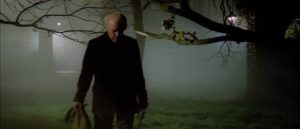
© Silenia Cinematografica / Italian International Film
But the cat seems to have picked up some other things, including super-intelligence and super-strength, for it can hypnotise its victims, sabotage ventilation systems, set furniture on fire, come back from the dead and even, like those silly zombies in City of the Living Dead, teleport. You wonder why with all these talents the cat ever bothers to scratch anyone, but it does that too. Still, the film has a few impressively eerie sequences, such as when Magee totters down to the village graveyard after dark and tests out his new contacting-the-dead wireless equipment.
Fulci is remembered for one more ‘major’ horror film, 1982’s The New York Ripper. A serial killer / slasher effort with a self-explanatory title, this was controversial to say the least and led to him being accused of misogyny. Even if Britain hadn’t been so jittery at the time about Video Nasties, the fact that it appeared soon after the real-life Yorkshire Ripper killings in northern England probably meant it was never going to get a British cinematic release. The New York Ripper is a gruelling film and, frankly, a pretty bad one. The killer’s quirk of performing Donald Duck impersonations during the murders isn’t so much deeply disturbing as deeply stupid. If nothing else, the film serves as a record of the sleaze and dodginess associated with New York in the 1970s and 1980s. This, of course, was before the city was cleaned up in the 1990s by its mayor, the totally non-sleazy, non-dodgy Rudy Giuliani
Thereafter, Fulci’s output tailed off in both prominence and quality due to a series of misfortunes that included a fall-out with his long-term scriptwriting collaborator Dardano Sacchetti and some serious health problems like hepatitis, cirrhosis and diabetes. Although ‘quality’ is a subjective concept when you’re discussing his movies anyway. He soldiered on into the early 1990s, his last directorial effort being the poorly received psychological thriller Door to Silence in 1991. I’ve watched a single movie from his later years, a 1987 teen-orientated horror film called Aenigma that was apparently filmed in the then-Yugoslavia and is a weak rip-off of Brian De Palma’s Carrie (1976) and Richard Franklin’s telekinesis thriller Patrick (1978). One thing I’ll say about Aenigma is that its death-by-snails sequence has to be seen to be believed.
Lucio Fulci died impoverished, sick and alone in Rome in 1996. At least he had the satisfaction of attending, two months prior to his death, a convention in New York organised by the American horror-movie magazine Fangoria. Much to his astonishment, since he didn’t appreciate his popularity beyond the shores of Italy, he was mobbed at the convention by thousands of American fans.
Funnily enough, Fulci’s films make me think of Gerry Anderson’s sci-fi-puppet TV show from 1964, Stingray. Each episode of Stingray would open with a voice intoning, “Anything can happen in the next half-hour!” That line would make a suitable opening for a typical Lucio Fulci movie too: “Anything can happen in the next hour-and-a-half!” Especially if the film takes place on top of a portal to hell.

© Medusa Distribuzione




